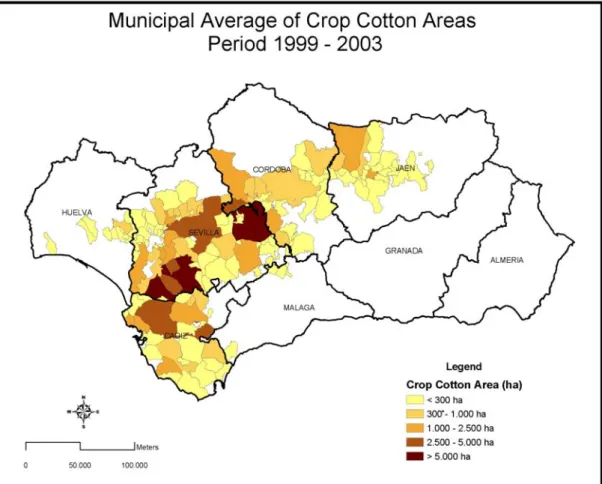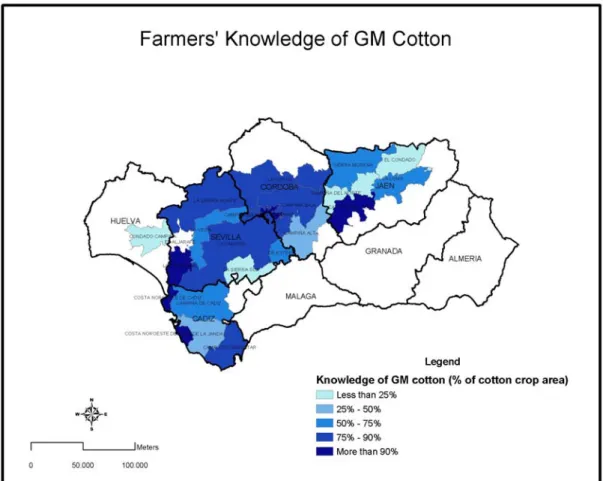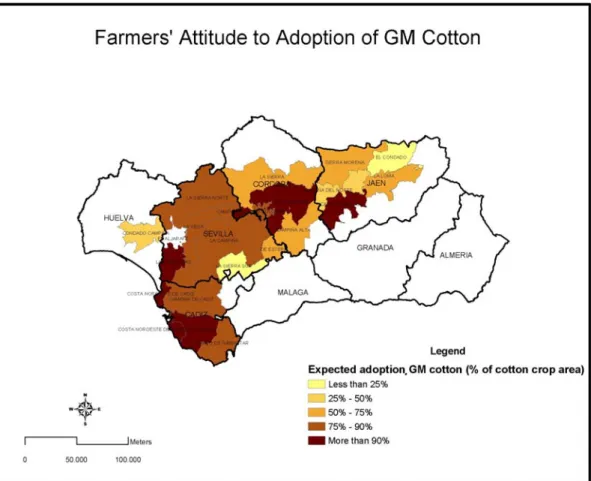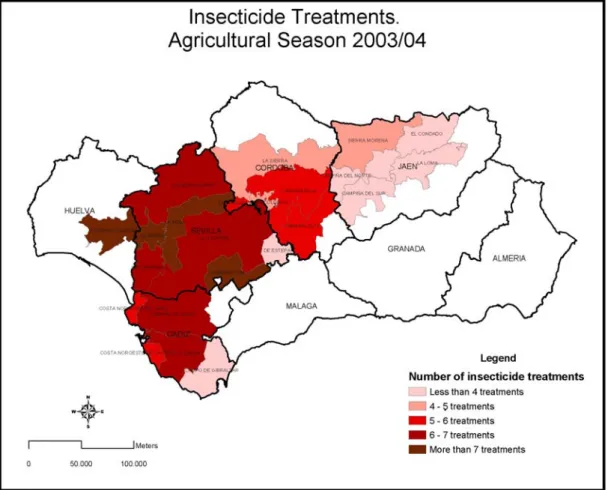The 11th International Congress of
THE EUROPEAN ASSOCIATION OF AGRICULTURAL ECONOMISTS
Poster Background Paper
ESTIMATE OF THE POTENTIAL ADOPTION OF GENETICALLY
MODIFIED COTTON BY FARMERS IN SOUTHERN SPAIN AND ITS
ECONOMIC IMPLICATIONS
Manuel Gómez-Barbero & Emilio Rodriguez-Cerezo
EUROPEAN COMMISSION
DG JRC-Institute for Prospective Technological Studies Sustainability in Agriculture, Food and Health Unit
C/ Inca Garcilaso s/n (Edificio Expo) 41092 Seville (Spain)
E-mails: manuel.gomez@cec.eu.int & emilio.rodriguez-cerezo@cec.eu.int http://www.jrc.es
Paper prepared for presentation at the 99th seminar of the EAAE (European Association of Agricultural Economists), “The Future of Rural Europe in the Global Agri-Food System”,
Copenhagen, Denmark. 24-27 August 2005.
Copyright 2005 by Manuel Gómez-Barbero and Emilio Rodriguez-Cerezo. All rights reserved. Readers may make verbatim copies of this document for non-commercial purposes by any means, provided that this copyright notice appears on all such copies. The views expressed in this paper are those of the authors and do not necessarily correspond to those of the European Commission.
ESTIMATE OF THE POTENTIAL ADOPTION OF GENETICALLY
MODIFIED COTTON BY FARMERS IN SOUTHERN SPAIN AND ITS
ECONOMIC IMPLICATIONS
Abstract
This paper analyses the potential adoption and economic on-farm impact of Bt cotton in the Andalusia region (southern Spain). Survey data have shown that,on average, 58% of the responding farmers know about genetically modified (GM) cotton. Another outcome of the survey is that 95% of the farmers declaring that they know about GM cotton would be willing to grow Bt cotton. In the main cotton-producing districts, farmers’ attitudes are positive, and they would be willing to adopt the technology. In areas where the crop is more important, the farmers who are willing to adopt Bt cotton represent over 75% of the area under cotton. As regards the on-farm economic impact resulting from a potential adoption, the assessment is that savings on the cost of direct pest control will be achieved by reducing the number of insecticide treatments. This analysis is applied to a representative Andalusian cotton farm. On the basis of the worst-case scenario derived from a review of the literature on the economic performance of Bt cotton, a reduction of 2.6 insecticide treatments is assumed. For our representative farm this would result in a cost saving of € 148.2 per hectare.
Introduction
Cotton is a very important industrial crop for many countries in the world. It is the world’s leading non-food crop both in terms of the amount of land cultivated and the economic turnover it generates. The fruit of the cotton plant consists of a seedpod (boll) containing oil-bearing seeds whose epidermal cells produce cellulose fibres. Cotton is mainly grown for fibre production. In addition, cotton seed is a by-product used as to produce edible oils or cosmetics, and is also processed into meal cakes for animal feed.
Cotton is grown in warm areas with a rainy season or under irrigation, the main producers being China, the United States and Pakistan. The importance of cotton in large areas of the world has made it one of the main focuses of traditional genetic improvement, and in recent years, of breeding by means of modern biotechnology and genetic engineering.
The European Union (EU) cotton production is hardly relevant on a world scale. The crop is grown in Greece and Spain and amounts to only 1.3% of the world total and about 460,000 hectares. Nevertheless, the crop is economically and socially significant in those European regions where it is produced, such as Andalusia (southern Spain) where it covers around 92,475 hectares according to 2003/04 data. In this region, cotton cultivation involves 1.5 million man/days per year, of which 85% is family labour (Bilbao et al., 2004).
Cotton is attacked by a number of insect pests that reduce yields, such as bollworm. The so-called
Bt cotton varieties express a toxin from the soil bacterium Bacillus thuringiensis to reduce/eliminate this damage as a result of the insertion (via genetic engineering) of a gene from this bacterium. Weeds are also a major problem for cotton production. Varieties of genetically modified (GM) cotton have been created which tolerate the herbicides bromoxynil and glyphosate (HT cotton). The latest cotton varieties improved by genetic engineering combine both insect resistance and tolerance to the herbicide glyphosate and are commonly known as Bt/HT cotton.
The EU has not authorised the cultivation of any of the different types of GM cotton, but five marketing applications have been received by Community authorities. Two of these applications cover all possible uses, including cultivation. They relate to insect-resistant cotton (Bt cotton) containing the event IPC531, applied by Spain in 1996, and glyphosate tolerant cotton (HT cotton) containing the event RRC1445 applied, again by Spain, in 1997. Both applications were presented under Council Directive 90/220/EEC of 23 April 1990 on the deliberate release into the environment of genetically-modified organisms. The EU Scientific Committee was in favour of their authorisation, and in 2003 the applications were redrafted and adapted to the new Directive 2001/18/EC of the Parliament and the Council of 12 March 2001 on the deliberate release into the environment of genetically-modified organisms, which repealed Directive 90/220/EEC.
The cultivation of GM cotton varieties in the EU could have economic implications for the EU’s cotton producing sector, since there are serious concerns about how to improve its competitiveness by reducing production costs, especially after the recent reform of the Community aid scheme for cotton (EC Regulation Nº 864/04). For the farmer, GM cotton varieties allow the number of applications of plant protection products (which are a major component of the production cost) to be reduced, as well as facilitating pest and weed control. It is therefore likely that, if their cultivation is authorised, some farmers in the cotton-producing regions will adopt these GM varieties.
This paper carries out an ex-ante analysis with a twofold objective: to measure the potential adoption of Bt cotton by Andalusian farmers based on the results of a survey and to make an initial estimate of its on-farm economic impact. At the time of submitting this paper, the research is at an early stage and only interim results are shown. A more detailed analysis is necessary, especially for estimating the potential economic impact derived from the adoption of Bt cotton.
The paper is laid out as follows: the next section presents an overview of the global adoption of GM cotton and its economic performance in the different countries. After that, based on survey data, we estimate the potential extent of the adoption of Bt cotton in Andalusia. In this section we also study the relationships between the adoption of GM cotton, the extent of farmers’ knowledge about it, and the
number of insecticide treatments. The last section discusses the findings, draws conclusions, shows a simple economic analysis and introduces future research.
Overview of the global adoption of GM cotton and economic performance
Eight countries grew GM cotton on 9.0 million hectares in 2004 using the three types of GM cotton available (Bt, Bt/HT and HT). These countries are the United States, India, China, Australia, South Africa, Argentina, Colombia and Mexico. They account for 11% of the area under GM crops world-wide. Table 1 shows the trend in the area of GM cotton cultivation since its introduction in 1996 (ISAAA, 2004 and James, 2005).During the nine-year period from 1996 to 2004, Bt cotton has been the most dominant type of GM cotton in terms of area. In 2004, it occupied 4.5 million hectares and accounted for 50% of the area under GM cotton worldwide. Since 2001, Bt/HT cotton has been the second GM cotton, taking up 3 million hectares in 2004, which is equivalent to 33% of the GM cotton area worldwide.
Table 1: Evolution of GM cotton and traits
1996 1997 1998 1999 2000 2001 2002 2003 2004
Trait (Million hectares)
Bt Cotton 0.8 1.1 1 1.3 1.5 2.1 2.4 3.1 4.5 Bt/HT Cotton 0 <0.1 -- 0.8 1.7 1.9 2.2 2.6 3 Ht Cotton <0.1 0.4 -- 1.6 2.1 1.8 2.2 1.5 1.5 Total GM Cotton 0.8 1.5 1 3.7 5.3 5.8 6.8 7.2 9
Source: Adapted from ISAAA, 2004 and James, 2005
The adoption of GM cotton involves potential on-farm effects on both revenues and costs. Price differences between non-GM and GM crops, yield variation, seed prices, pest control and other operating costs are key factors affecting the profitability of GM cotton. Bt crops are designed to reduce yield losses caused by pests. HT crops are expected to save costs through different/reduced and more flexible weed management regimes. GM seeds are more expensive than conventional seeds. Lastly, the introduction of GM technology may bring additional operating costs, such as the maintenance of buffer zones (so-called “mandatory refuges” in the case of Bt crops, to avoid the emergence of resistant insect populations) or, in certain areas of the world, including the European Union, additional costs incurred by GM farmers in ensuring coexistence with non-GM crops.
There are also non-pecuniary benefits from sowing GM crops. The literature refers to them as environmental improvements (reduced use of inputs or use of less toxic pesticides) and improvements in farmers’ health particularly in undeveloped countries where pest management is carried out with little or no protection for workers.
Unlike other GM crops, there is a reasonable body of evidence (based on published research) about the on-farm performance of GM cotton compared to non-GM varieties. Specifically, several studies on Bt cotton have been conducted in countries such as China, India, South Africa, Argentina, the United States and Australia (Huang et al., 2003; Pray et al., 2001; Qaim, 2003; Qaim and Ziberman, 2003; Thirle et al., 2003; Qaim and de Janvry, 2003; Traxler et al., 2003 and Fitt, 2003). All these studies show higher average yields for Bt cotton. The impact of the higher price of GM seeds is normally offset by lower pest control costs, resulting in lower production costs. These two factors led to higher gross margins for Bt
farmers. All of these studies reported that fewer insecticide applications were needed for GM cotton crops compared with their non-GM counterparts.
Other studies estimate the global benefit obtained from the adoption of Bt cotton in the United States, China and India and show its distribution among the economic agents involved in the GMO supply chain (biotech industry, seed suppliers, farmers and consumers) (Falck-Zepeda et al., 2000a; Falck Zepeda
et al., 2000b; Anderson and Yao, 2003 and Qaim 2003). In all cases, an increase in global welfare is reported for all the agents, with farmers as the main beneficiaries, followed by the industry and consumers.
Estimating the potential adoption of GM cotton in Andalusia (Southern Spain)
Overview of cotton production in Andalusia
Andalusia accounts for 98% of the Spanish cotton area, with about 92,475 hectares according to the 2003/04 data. The crop is grown mainly in the Guadalquivir Valley and, to a lesser extent, in the Genil and Guadalete Valleys, on the Cadiz coast and in the countryside surrounding Seville. Figure 1 shows a map of the eight provinces of Andalusia with a detailed distribution (at municipality level) of the Andalusian cotton crop area. The region surrounding the middle and lower reaches of the Guadalquivir River has the highest concentration of cotton.
Figure 1. Distribution of the cotton crop area, 1999-2003.
Source: FAGA. Regional Ministry of Agriculture and Fisheries.
A survey to estimate ex-ante adoption of GM cotton by farmers in Andalusia
To identify potential areas and possible rates of adoption for Bt cotton in Andalusia, a multi-client survey was conducted on the total population of cotton growers in the region (9 418 farmers). A
questionnaire was sent by normal mail, achieving a response rate of 8.81% (830 cotton farmers). However, when results are broken down by farming district, only 630 answers are considered. This is because 200 farmers did not answer the question asking which district they belonged to.
Degree of knowledge about genetically modified cotton by district
Farmers were asked about their knowledge of GM cotton. On average, 58% of respondents (830 farmers) knew of it, 30% did not know and 12% did not answer this question. Figure 2 presents the results of the survey on the level of knowledge broken down by district. The results are expressed as a percentage of cotton surface area in each district represented by farmers with a knowledge of GM cotton. Only in four districts (Condado and Campiña del Norte districts in Jaén, Sierra Sur in Seville and Condado Campiña district in Huelva) does the percentage of cotton surface area cultivated by farmers declaring a knowledge of GM cotton drop below 25%. The remaining districts show a high or relatively high level of knowledge.
Figure 2. Percentage of cotton crop area in each Andalusian district cultivated by farmers declaring knowledge of GM cotton.
Results of the survey of Andalusian farmers´ attitude towards adoption of GM cotton
The attitude of the farmers in the main cotton-producing districts towards the possible adoption of GM cotton is positive, and farmers would be willing to grow it. Figure 3 shows the percentage of the crop area that would grow GM cotton, broken down by district. It can be observed that in the zones where the crop is more important (Figure 1), such as the Guadalquivir Valley, the Marisma marshlands, the Campiña
de Cádiz and La Janda, the farmers willing to adopt GM cotton represent over 75% of the cotton crop area (Figure 3).
Based on the 830 answers and looking at the relationship between the two variables (knowledge of GM cotton and willingness to adopt it), the results show that 95% of the farmers declaring a knowledge of GM cotton would be willing to grow it. On the other hand, just 4% of farmers declaring that they have no knowledge of GM cotton would be willing to adopt it.
Figure 3. Percentage of cotton crop area where farmers are willing to adopt GM cotton in Andalusia (by district).
Results of the survey on current agricultural practices for cotton pest control in Andalusia Figure 4 shows the average number of insecticide treatments applied to cotton fields in the season 2003/4 (per district). Geographical differences can be seen in the number of treatments; there are more treatments in the middle and lower reaches of the Guadalquivir, where average temperatures are higher. The crop is more widespread (with a consequent higher risk of specific pests), there is a higher degree of specialization on the farms, a predominance of gravity irrigation systems (supplying more irrigation water) and more intensive cultivation (greater use of plastic mulching, etc.).
When comparing the distribution of the number of insecticide treatments (Figure 4) against the willingness to adopt Bt cotton (Figure 3), there is no clear relationship between the two variables. After performing a linear regression and a correlation analysis, the correlation coefficient is positive but extremely low. This is in part due to the role played by the variable level of knowledge about GM crops. There are several districts where the number of insecticide treatments is above average (about 6 treatments for the 630 farmers), but the knowledge of GM crops is below the average (51% for the 630 farmers).
Figure 4. Average number of insecticide treatments in cotton fields (by district) in 2003/04.
Discussion and conclusions
This paper has analyzed the potential adoption of Bt cotton by Andalusian farmers. The
results show that, on average, 58% of the 830 responding farmers knew about GM cotton, 30% did not
know and 12% did not answer this question. By district, most of the respondents show a high or relatively high level of knowledge.
95% of the farmers declaring a knowledge of GM cotton would be willing to grow Bt cotton. This can be considered as a high potential rate of adoption. In the main cotton-producing districts, farmers’ attitudes are positive, and they would be willing to cultivate Bt cotton. In the areas where the crop is more important, the farmers who are willing to adopt Bt cotton represent over 75% of the cotton crop area.
Comparing the distribution of the number of insecticide treatments with the willingness to adopt
Bt cotton shows no clear statistical relationship between the two variables. Part of the reason is that there are several districts where the number of insecticide treatments is high but knowledge of GM crops is low. However, further statistical analysis is needed and this will be one of the next steps of this research.
As regards the on-farm economic impact, an initial approach can be to estimate the pest control cost savings through reducing the number of insecticide treatments by adopting Bt cotton. For this simple analysis we have not considered other sources of profitability such as price differences between GM and conventional seeds, output prices or variation in yields. A representative Andalusian cotton farm could have the following direct costs for pest control: insecticide € 300 per hectare; 6 insecticide treatments € 39 per hectare (Bilbao, 2004). Total direct pest control costs per hectare are around € 57. The published literature reviewed in Section 2 shows that applications of insecticide in the various countries are between
2.6 and 6 times fewer when adopting Bt cotton. Taking the worst-case scenario, a reduction of 2.6 applications of insecticide in our representative farm would result in a saving of € 148.2 per hectare. Will these costs savings cover probable price differences between GM and conventional seeds?
As mentioned in the first section, at the time of submitting this paper, this research is at an early stage. Therefore, a more detailed analysis of the potential adoption of Bt cotton in Andalusia and its economic impact is the objective of our future research.
Little research has been devoted to evaluate ex ante the potential adoption of GM crops in the European Union. Desquilbert et al. (2003) evaluated the benefits derived from the potential adoption of HT rapeseed in France. May (2003) analysed ex ante the economic consequences for UK farmers of a potential of HT sugar beet. Lastly, Demont and Tollens (2003) studied the potential welfare derived of introducing HT sugar beet in the EU and its distribution between different economic agents/regions. This type of ex ante studies are very useful to determinate the benefits or opportunity costs derived from adopting or not GM crops. However, their results should be interpreted with caution since they are based on many assumptions. The sensitivity of the outcomes to variations in key parameters of the models should be clearly documented. When estimating the economic welfare (aggregated gains) of the adoption, one of the most important assumptions usually made is the rate of adoption which in our case can be easily calculated using statistic inference.
For our further analysis of the economic consequences of growing Bt cotton, a new element has to be calculated: the potential costs or income losses incurred by GM farmers in order to ensure coexistence with non GM-crops. In 2003, the European Commission published a recommendation on guidelines for the development of national strategies and best practices to ensure the co-existence of GM, conventional and organic crops (2003/556/EC). The guidelines recommend that those farmers bringing in the
innovation into a region should be the ones taking measures and changing practices if needed to ensure coexistence. In the current EU situation, the innovators would then be the GM farmers and thus the ones taking the measures (if necessary) and incurring in costs or revenues losses (if any).
References
Anderson, K. and Yao S. (2003). China, GMOs and world trade in agricultural and textile products. Pacific Economic Review 8, no. 2: 157-169.
Bilbao, M., Méndez, M., Lucena, B., Cáceres, F., Manrique, T., Granado, R., Polonio, D., Fernández, R., Fernández, R., Velasco, R., Parras, T., Serrano, E., Cruz, J.C., Ruiz, M.C. (2004). Diagnóstico del sector algodonero andaluz (draft). Servicio de estudios y estadísticas de la Consejería de Agricultura y Pesca. Unidad de Prospectiva (Córdoba).
Demont, M., and Tollens, M. (2003). Ex Ante Welfare Effects of Agricultural Biotechnology in the European Union: The Case of Transgenic Herbicide Tolerant Sugarbeet in Evenson, R. E. and Santaniello, V. (eds). The Regulation of Agricultural Biotechnology. (ed) Wallingford, UK, CAB International.
Desquilbet, M., Lemarié, S., et al. (2001). Potential adoption of GM rapeseed in France, effects on revenues of farmers and upstream companies: an ex ante evaluation. 5th ICABR conference Biotechnology, science and modern agriculture: a new industry at the dawn of the century, Ravello, Italy.
Falck-Zepeda, J. B., Traxler, G. and Nelson, R. G. (2000). Rent Creation and Distribution from Biotechnology Innovations: The case of Bt cotton and Herbicide-Tolerant soybean in 1997. Agribusiness 16, no. 1: 21-32.
Falck-Zepeda, J.B., Traxler, G. and Nelson, R. G. (2000). Surplus distribution from the introduction of Biotechnology Innovation. American Journal of Agricultural Economics 82, no. 2: 360-369. Fernandez-Cornejo, J., and McBride, W. (2000) Genetically engineered crops for pest management in US
Fitt, G. P. (2003). Deployment and impact of transgenic Bt cotton in Australia. N. Kalaitzandonakes (ed). New York: Kluwer Academic/Plenum Publishers, 141-164.
Huang, J., R. Hu, C. Pray, F. Qiao, and Rozelle S. (2003). Biotechnology as an alternative to chemical pesticides: a case study of Bt cotton in China. Agricultural Economics 29: 55-67.
Huang, J., Hu, R., Rozelle, S., Qiao, F. and Pray, C. (2002). Transgenic varieties and productivity of smallholder cotton farmers in China. The Australian Journal of Agricultural and Resource Economics 46, no. 3: 367-387.
ISAAA (2004) Global Adoption of Bt Cotton, 1996-2003, ISAAA (ed.). Metro Manila (Philippines), ISAAA.
James, C. (2004) Dominant Transgenic Crops in 2003. ISAAA (ed). Metro Manila (Philippines), ISAAA. James, C. (2005) Preview: Global Status of Commercialized Biotech/GM Crops in 2004. ISAAA (ed).
Ithaka NY, ISAAA.
Lusk, J.L., Moore, M., House, L.O. and Morrow, B. (2002). Influence of brand name and type of modification on consumer acceptance of genetically engineered corn chips: a preliminary analysis. International Food and Agribusiness Management Review 4:373-383.
May, M. J. (2003). Economic consequences for UK farmers of growing GM herbicide tolerant sugar beet. Annuals of Applied Biology 142: 41-48.
Pray, C., Ma, D., Huang, J. and Qiao, F. (2001). Impact of Bt Cotton in China. World Development 29, no. 5: 813-825.
Qaim, M. Bt Cotton in India (2003): Field Trial Results and Economic Projections. World Development 31, no. 12: 2115-2127.
Qaim, M. and de Janvry, A. (2003). Genetically modified crops, corporate pricing strategies, and farmers´adoption: the case of Bt cotton in Argentina." American Journal of Agricultural Economics 85, no. 4: 814-828.
Qaim, M. and Zilberman D. (2003). Yield Effects of Genetically Modified Crops in Developing Countries. Science 299, no. 5608: 765-960.
Thirtle, C., L. Beyers, Y. Ismael, and Piesse J. (2003). Can GM-Technologies Help the Poor? The Impact of Bt Cotton in Makhathini Flats, KwaZulu-Natal." World Development 31, no. 4: 717-732. Traxler, G., S. Godoy-Avila, J. Falck-Zepeda, and Espinoza-Arellano, J.J. (2003) Transgenic Cotton in
Mexico: a Case Study of the Comarca Lagunera. Kalaitzandonakes (ed). Missouri (Columbia State), pp. 183-202.
Weick, C.W. and Walchli, S.B. (2002). Genetically engineered crops and foods: back to the basics of technology diffusion. Technology in Society 24: 265-283.




